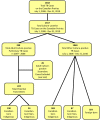Tuberculosis transmission in the Indigenous peoples of the Canadian prairies
- PMID: 29136652
- PMCID: PMC5685619
- DOI: 10.1371/journal.pone.0188189
Tuberculosis transmission in the Indigenous peoples of the Canadian prairies
Abstract
Setting: The prairie provinces of Canada.
Objective: To characterize tuberculosis (TB) transmission among the Indigenous and non-Indigenous Canadian-born peoples of the prairie provinces of Canada.
Design: A prospective epidemiologic study of consecutively diagnosed adult (age ≥ 14 years) Canadian-born culture-positive pulmonary TB cases on the prairies, hereafter termed "potential transmitters," and the transmission events generated by them. "Transmission events" included new positive tuberculin skin tests (TSTs), TST conversions, and secondary cases among contacts.
Results: In the years 2007 and 2008, 222 potential transmitters were diagnosed on the prairies. Of these, the vast majority (198; 89.2%) were Indigenous peoples who resided in either an Indigenous community (135; 68.2%) or a major metropolitan area (44; 22.2%). Over the 4.5-year period between July 1st, 2006 and December 31st 2010, 1085 transmission events occurred in connection with these potential transmitters. Most of these transmission events were attributable to potential transmitters who identified as Indigenous (94.5%). With a few notable exceptions most transmitters and their infected contacts resided in the same community type. In multivariate models positive smear status and a higher number of close contacts were associated with increased transmission; adjusted odds ratios (ORs) and 95% confidence intervals (CIs), 4.30 [1.88, 9.84] and 2.88 [1.31, 6.34], respectively. Among infected contacts, being Indigenous was associated with disease progression; OR and 95% CI, 3.59 [1.27, 10.14] and 6.89 [2.04, 23.25] depending upon Indigenous group, while being an infected casual contact was less likely than being a close contact to be associated with disease progression, 0.66 [0.44, 1.00].
Conclusion: In the prairie provinces of Canada and among Canadian-born persons, Indigenous peoples account for the vast majority of cases with the potential to transmit as well as the vast majority of infected contacts. Active case finding and preventative therapy measures need to focus on high-incidence Indigenous communities.
Conflict of interest statement
Figures


References
-
- Brancker A, Enarson DA, Grzybowski S, Hershfield ES, Jeanes CWL. A statistical chronicle of tuberculosis in Canada: Part I. From the era of sanatorium treatment to the present. Part II. Risk today and control. Statistics Canada, Cat. 82–003. Health Reports 1992;4:103–23; 277–92. - PubMed
-
- Public Health Agency of Canada. Tuberculosis in Canada 2014 –Pre-release. Ottawa (Canada): Minister of Public Works and Government Services Canada; 2016.
-
- Wherrett GJ. The miracle of the empty beds: A history of tuberculosis in Canada. Toronto: University of Toronto Press; 1977.
-
- Canadian Charter of Rights and Freedoms. Constitution Act, 1982(1). <www.solon.org/Constitutions/Canada/English/ca_1982.html> (Accessed October 26, 2016).
MeSH terms
LinkOut - more resources
Full Text Sources
Other Literature Sources
Medical

